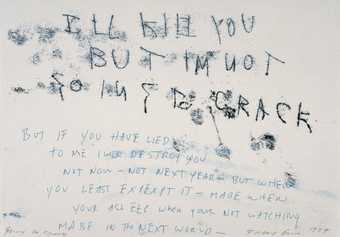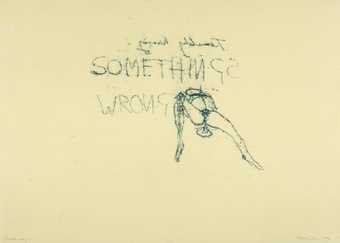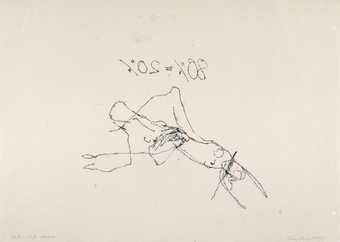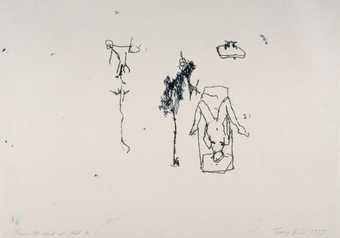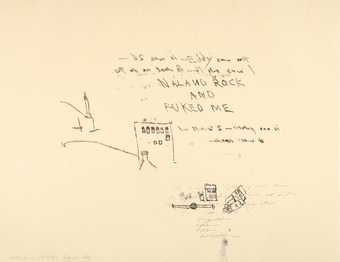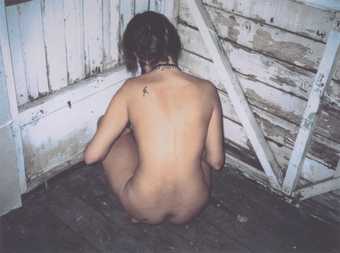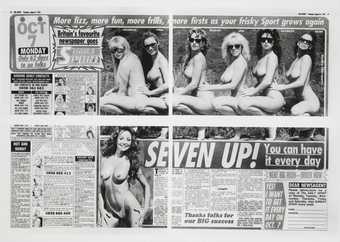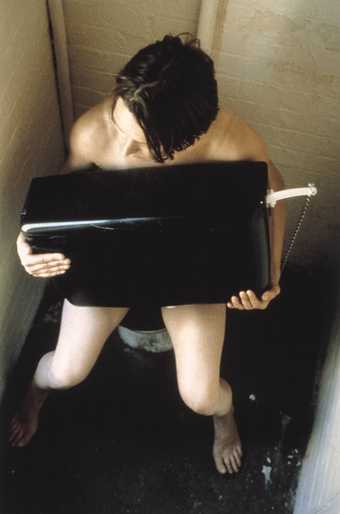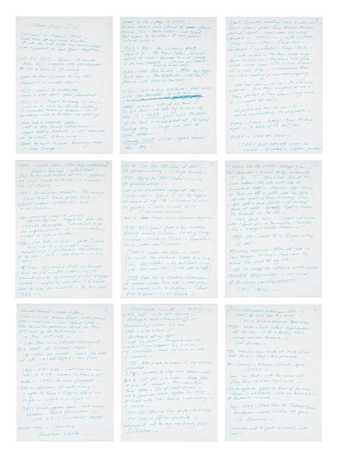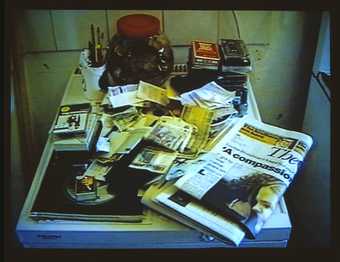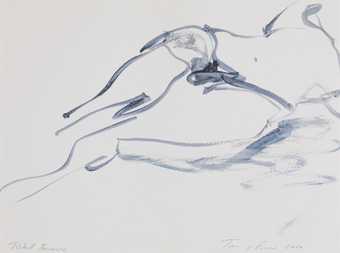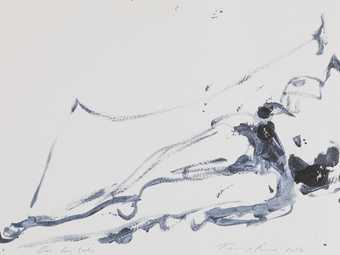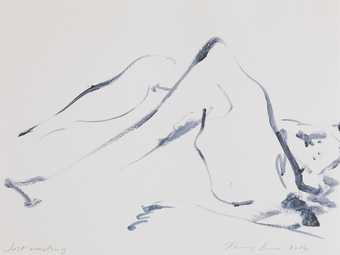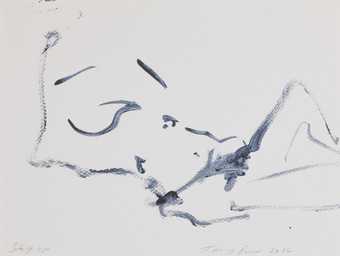
In Tate Britain
Prints and Drawings Room
View by appointment- Artist
- Tracey Emin born 1963
- Medium
- Monoprint on paper
- Dimensions
- Support: 420 × 593 mm
- Collection
- Tate
- Acquisition
- Presented by the Patrons of New Art (Special Purchase Fund) through the Tate Gallery Foundation 1999
- Reference
- P11567
Summary
Presented by the Patrons of New Art (Special Purchase Fund) through the Tate Gallery Foundation 1999
P11567
Emin's monoprints have a diaristic aspect and frequently depict events from the past. Often they incorporate text as well as image, although some bear only text and others only image. The text appears as the artist's stream of consciousness voice. The rapid, one-off technique involved in making monoprints is perfectly suited to (apparently) immediate expression, as is Emin's scratchy and informal drawing style. Rarely displayed alone, the monoprints are particularly effective as collective fragments of intense emotional confrontation. Emin has made several works documenting painful moments of sadness and loneliness experienced when travelling to foreign cities for various exhibitions. Sad Shower in New York was made after a trip to New York when Emin has said that she was feeling 'pathetic and despondent' (in conversation with the author, July 2001). She has added the date 'May 95' to the title on the print. It shows her standing under a shower looking dejected and alone. 80% - 20% Canada (see Tate P11566) also records feelings from an overseas trip. Emin has stated:
For me, aggression, sex and beauty go together. Much of my work has been about memory, for example, but memories of violence and pain. Nowadays if I make a drawing I'm trying to draw love, but love isn't always gentle Being an artist isn't just about making nice things, or people patting you on the back; it's some kind of communication, a message.
(Quoted in Morgan, pp.59-60.)
Emin's artistic production began in the early to mid 1980s with printmaking and painting. She was inspired by Austrian artist Egon Schiele (1890-1918) and the German Expressionists, whose work she became aware of while studying at Maidstone College of Art (1983-6). Aspects of these early influences remain both in her subject matter and her style. Emin presents the records of her past as objects of iconic status, positing her persona (or the performance of it) as central. By basing her art on her emotional life, through the narration of frequently traumatic and abusive experiences, Emin has found a way to redeem her personal damage and to communicate on a direct and open level with her audience. She follows the precedence of Louise Bourgeois (born 1911), who has been making a direct connection between her art and her childhood traumas since the early 1980s, producing an Autobiographical Series of prints in 1994 (Tate P77682-95). Emin's raw and brutal honesty exposes the mixture of pathos, vulnerability, resentment and frank aggression which makes humanity so complex.
Further reading:
Sex and the British, exhibition catalogue, Galerie Thaddeus Ropac, Salzburg 2000, pp.3-4 and 25-9
Neal Brown, Sarah Kent, Matthew Collings, Tracey Emin: I Need Art Like I Need God, exhibition catalogue, Jay Jopling, London 1998, p.6
Stuart Morgan, 'The Story of I: Interview with Tracey Emin', Frieze, issue 34, May 1997, pp.56-61
Elizabeth Manchester
July 2001
Does this text contain inaccurate information or language that you feel we should improve or change? We would like to hear from you.
Display caption
Emin places herself centre-stage in
her work, telling intimate stories about her life. 'It's like a cleansing of my soul.
It's not just getting rid of baggage or carnage. It's not that simple. Something actually happens within me.'
Several of the works refer to traumas, such as having an abortion or splitting up with her boyfriend. These painful events are conveyed with brutal simplicity and candour but, as she says, 'Being an artist isn't just about making nice things, or people patting you on the back; it's some kind of communication, a message'.
Gallery label, November 2002
Does this text contain inaccurate information or language that you feel we should improve or change? We would like to hear from you.
Explore
- emotions, concepts and ideas(16,416)
-
- emotions and human qualities(5,345)
-
- isolation(290)
- sadness(202)
- vulnerability(311)
- furnishings(3,081)
-
- shower(10)
- actions: processes and functions(2,161)
-
- washing / drying(101)
- woman(9,110)
- female(1,681)
You might like
-
Tracey Emin Going to Crack
1997 -
Tracey Emin Terribly Wrong
1997 -
Tracey Emin 80%-20% Canada
1997 -
Tracey Emin From the Week of Hell ‘94
1995 -
Tracey Emin Fuck You Eddy
1995 -
Tracey Emin The Last Thing I Said to You was Don’t Leave Me Here II
2000 -
Sarah Lucas Seven Up
1991 -
Sarah Lucas Human Toilet II
1996 -
Tracey Emin Tracey Emin C.V.
1995 -
Tracey Emin Tracey Emin C.V. Cunt Vernacular
1997 -
Tracey Emin Monument Valley (Grand Scale)
1995–7 -
Tracey Emin Total Reverse
2014 -
Tracey Emin On her Side
2014 -
Tracey Emin Just Waiting
2014 -
Tracey Emin Stay Up
2014

